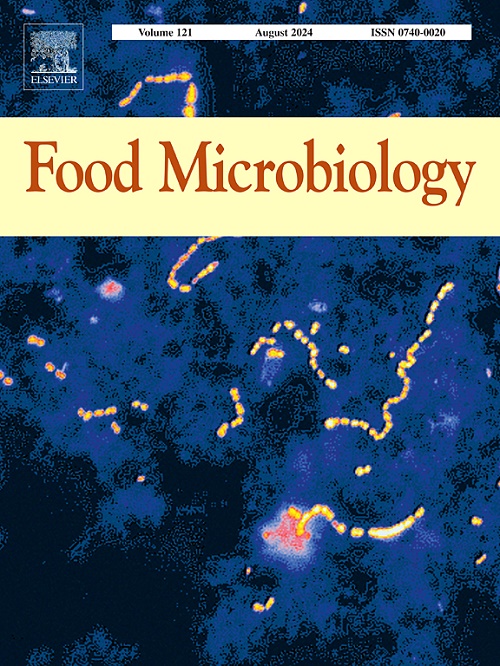Assessment of antimicrobial properties of a curcumin-loaded nano-emulsion in reducing pathogen loads on cantaloupe surface (Cucumis melo L.)
IF 4.5
1区 农林科学
Q1 BIOTECHNOLOGY & APPLIED MICROBIOLOGY
引用次数: 0
Abstract
Curcumin (CUR) exhibits antimicrobial properties but is hindered by chemical instability, limiting its direct application. This study evaluated the efficacy of curcumin nanoemulsions (CUR-NE) in reducing pathogenic microorganisms on cantaloupe rind surfaces. Two CUR-NE formulations, 1CUR-NE (0.05% CUR, w/w) and 2CUR-NE (0.10% CUR, w/w), were prepared by mixing CUR with medium-chain triglyceride (MCT) oil (3% w/w), polysorbate 80 (2% w/w), and polyethylene glycol (10% w/w), followed by a 15-min ultrasound treatment (175 W). The antimicrobial effects were assessed against Listeria innocua B-33016, Escherichia coli ATCC25922, aerobic bacteria, and yeast and mold. Inoculated cantaloupe surfaces were treated with CUR-NE, and microbial counts were analyzed on days 1, 3, 6, 9, and 12. The viscosity of 1CUR-NE and 2CUR-NE was 0.0030 ± 0.0001 Pa s and 0.0027 ± 0.0006 Pa s, with droplet sizes of 122.47 ± 3.06 nm and 137.67 ± 1.36 nm, respectively. Treatment with 2CUR-NE significantly reduced L. innocua growth on day 6 (2.50 ± 1.00 log CFU/cm2), with E. coli showing significant reductions on days 6 (1.55 ± 0.40 log CFU/cm2), 9 (1.91 ± 0.36 log CFU/cm2), and 12 (0.72 ± 0.26 log CFU/cm2). Scanning electron microscopy revealed a substantial decrease in microbial load after treatment. The results suggest that CUR-NE, particularly 2CUR-NE, effectively reduces pathogenic contamination on cantaloupe and offers a potential alternative to synthetic antimicrobial agents in food safety applications. Further studies are needed to explore the long-term efficacy and broader applications of CUR-NE in food systems.
载姜黄素纳米乳降低哈密瓜表面病原菌负荷的抗菌性能评价
姜黄素(Curcumin, CUR)具有抗菌性能,但由于化学不稳定,限制了其直接应用。本研究评价了姜黄素纳米乳(cur黄素- ne)对哈密瓜皮表面病原菌的抑制作用。将CUR与中链甘油三酯(MCT)油(3% w/w)、聚山梨酸80 (2% w/w)和聚乙二醇(10% w/w)混合,经超声处理(175 w) 15 min,制备出1CUR-NE (0.05% CUR, w/w)和2CUR-NE (0.10% CUR, w/w)两种CUR- ne配方,并评估其对innocuia李斯特菌B-33016、大肠杆菌ATCC25922、好氧细菌、酵母和霉菌的抗菌效果。接种后的哈密瓜表面用cu - ne处理,并在第1、3、6、9和12天分析微生物计数。1cu - ne和2cu - ne的黏度分别为0.0030±0.0001 Pa s和0.0027±0.0006 Pa s,液滴尺寸分别为122.47±3.06 nm和137.67±1.36 nm。2CUR-NE在第6天显著降低了无头乳杆菌的生长(2.50±1.00 log CFU/cm2),大肠杆菌在第6天显著降低(1.55±0.40 log CFU/cm2)、第9天(1.91±0.36 log CFU/cm2)和第12天(0.72±0.26 log CFU/cm2)。扫描电子显微镜显示处理后微生物负荷显著减少。结果表明,cu - ne,特别是2cu - ne,可有效降低哈密瓜致病性污染,在食品安全领域具有替代人工合成抗菌剂的潜力。需要进一步的研究来探索cu - ne在食品系统中的长期功效和更广泛的应用。
本文章由计算机程序翻译,如有差异,请以英文原文为准。
求助全文
约1分钟内获得全文
求助全文
来源期刊

Food microbiology
工程技术-生物工程与应用微生物
CiteScore
11.30
自引率
3.80%
发文量
179
审稿时长
44 days
期刊介绍:
Food Microbiology publishes original research articles, short communications, review papers, letters, news items and book reviews dealing with all aspects of the microbiology of foods. The editors aim to publish manuscripts of the highest quality which are both relevant and applicable to the broad field covered by the journal. Studies must be novel, have a clear connection to food microbiology, and be of general interest to the international community of food microbiologists. The editors make every effort to ensure rapid and fair reviews, resulting in timely publication of accepted manuscripts.
 求助内容:
求助内容: 应助结果提醒方式:
应助结果提醒方式:


